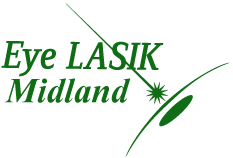We know the decision to have LASIK surgery is a big one, so we take great care to determine what’s best for you as our patient. That’s why we offer IntraLase as step one in your LASIK treatment.
With IntraLase, a beam of laser light is used to create your corneal flap, which is then lifted so the second step of LASIK—the reshaping of your cornea—can be performed. When your LASIK treatment is over, the flap is securely repositioned into place. This bladeless, computer-guided technology is 100 percent more accurate than most of the mechanical microkeratomes (hand-held device with a thin metal blade) that surgeons may also use to create a corneal flap.*
Because of the superior accuracy of IntraLase, certain patients who were ineligible for LASIK may now be able to have treatment. Ask your doctor today if you are a candidate.
IntraLase Offers Assurance and Comfort:
IntraLase has been used successfully on hundreds of thousands of eyes and we trust this advanced technology to deliver exceptional results. Our commitment is to provide you with the ultimate in comfort, safety, and outstanding vision. LASIK with IntraLase can help you achieve all of this—while it delivers the added assurance of knowing you’re being treated with the most advanced technology there is.
How IntraLase works:
Unlike mechanical instruments, IntraLase technology is uniquely able to program the dimensions of your flap based on what’s best for your eye. Then the IntraLase laser creates your flap from below the surface of the cornea—without ever cutting it. How?
1. IntraLase uses ultrafast pulses of laser light to position microscopic bubbles at a precise depth determined by your doctor.
2. The laser light passes harmlessly through your cornea. Then the laser creating rows of these bubbles just beneath your corneal surface as it moves back and forth across your eye in a uniform plane.
3. Next, the IntraLase laser stacks bubbles around your corneal diameter to create the edges of your flap. These bubbles are stacked at an angle that is determined by your doctor and is individualized to the way your eye is shaped.
4. The process takes only about 30 seconds from start to finish—it’s quiet and it’s comfortable.
5. Your doctor then gently lifts the flap to allow for the second step of your LASIK treatment. When treatment is complete, the flap easily “locks” back into position and rapidly begins to heal.
LASIK performed with IntraLase is preferred by patients
In a survey of clinical practices, the vision in the IntraLase-treated eye was preferred up to 3 to 1 by patients over the vision in the mechanical blade-treated eye (among those who stated a preference).**
LASIK performed with IntraLase delivers superior visual results
In a clinical study comparing the IntraLase laser to the leading microkeratome, more patients achieved 20/20 vision or better in standard and custom LASIK surgery when IntraLase was used to create the corneal flap.***
Sources:
*Wang M. Femtosecond technology: is now the time to buy? Refractive Eyecare for Ophthalmologists. May 2003;5:7.
** Daniel S Durrie, M.D.: Randomized prospective clinical study of LASIK: IntraLase versus mechanical keratome. Subsets presented at the Joint Meeting of the American Academy of Ophthalmology & the International Society of Refractive Surgery, November 14, 2003, Anaheim, CA, the Symposium of the American Society of Cataract & Refractive Surgery, May 4, 2004, San Diego, CA, the International Refractive Surgery: Science and Practice, October 23, 2004, New Orleans, LA, and the Symposium of the American Society of Cataract & Refractive Surgery, April 18, 2005, Washington, DC.
*** Durrie, DS, MD, Kezirian GM, MD. Femtosecond laser versus mechanical keratome flaps in wavefront-guided laser in situ keratomileusis: Prospective contralateral eye study. J Cataract Refract Surg. 2005;31:120-126.
Mkt Doc 213 Rev. A IntraLase is a registered trademark of IntraLase Corp.
Contact Eye LASIK Midland for a complimentary evaluation to learn if laser vision correction surgery is for you HERE or by clicking the image below.


